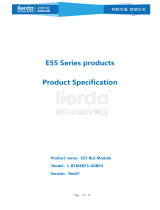PremierWave® 2050 802.11ac Embedded Wi-Fi® IoT Gateway Integration Guide 6
6. Component placement ________________________________________________ 35
7. Pre-Reflow Inspection ________________________________________________ 35
8. Reflow ____________________________________________________________ 38
9. Post Reflow Inspection _______________________________________________ 38
MSD (Moisture Sensitive Device) Control for the PW2050 Gateway __________________ 40
Product Information Label __________________________________________________ 41
Evaluation Board Schematic ________________________________________________ 42
List of Figures
Figure 2-1 PremierWave 2050 Dimensions and Views ____________________________ 11
Figure 2-2 PremierWave 2050 Block Diagram __________________________________ 12
Figure 2-3 PremierWave 2050 Pin Locations ___________________________________ 16
Figure 2-4 Reverse-SMA to U.FL (Long) (Lantronix Part Number 500-180-R-ACC) _____ 18
Figure 2-5 U.FL to U.FL Cable (Lantronix Part Number 500-181-R-ACC) _____________ 18
Figure 2-6 Reverse-SMA to U.FL (short) (Lantronix Part Number 500-182-R-ACC) _____ 18
Figure 2-7 PW2050 Gateway with Chip Antenna Board Edge Mounting ______________ 19
Figure 2-8 Serial Port Example ______________________________________________ 21
Figure 2-9 Ethernet Connections to an External 10/100 RJ45 Magnetic Jack (J5) _______ 23
Figure 2-10 USB Device Interface Example (PremierWave 2050 Wi-Fi only) ___________ 24
Figure 2-11 USB Host Interface Connections ___________________________________ 25
Figure 2-12 External Security Chip Connections _________________________________ 26
Figure 2-13 Recommended Use of SHDN Signal to Shut Off External Power Rail _______ 28
Figure 3-1 PremierWave 2050 Gateway Dimensions _____________________________ 29
Figure 3-2 PremierWave 2050 Recommended Footprint __________________________ 30
Figure 3-3 Recommended Reflow Profile ______________________________________ 32
Figure 3-4 SMT Process Flow _______________________________________________ 33
Figure 3-5 SPI Rectangle Pad 2876.5 mm Inspection Result _______________________ 34
Figure 3-6 SPI Square Pad 3850.7 mm Inspection Result __________________________ 35
Figure 3-7 X-Ray Machine Pre-Reflow Inspection ________________________________ 36
Figure 3-8 X-Ray Machine Post Reflow Inspection _______________________________ 38
Figure 3-9 PremierWave 2050 Product Label ___________________________________ 41
Figure 3-10 Evaluation Board Schematic (1 of 7) ________________________________ 42
Figure 3-11 Evaluation Board Schematic (2 of 7) ________________________________ 43
Figure 3-12 Evaluation Board Schematic (3 of 7) ________________________________ 44
Figure 3-13 Evaluation Board Schematic (4 of 7) ________________________________ 45
Figure 3-14 Evaluation Board Schematic (5 of 7) ________________________________ 46
Figure 3-15 Evaluation Board Schematic (6 of 7) ________________________________ 47
Figure 3-16 Evaluation Board Schematic (7 of 7) ________________________________ 48





















